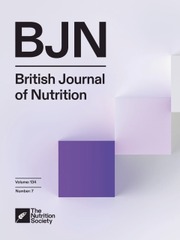No CrossRef data available.
Article contents
Consumption of ‘Moro’ and ‘Pera’ orange juices does not increase glycaemic and insulinaemic responses to other foods in adults
Published online by Cambridge University Press: 17 March 2025
Abstract
There has been concern regarding the consumption of fruit juices because of the high levels of naturally occurring sugars they contain, which could rapidly elevate glycaemic response and increase the risk of cardiometabolic diseases. We conducted two trials in which each volunteer ingested (1) white bread with 200 ml of two types of orange juice (OJ) prepared from ‘Moro’ and ‘Pera’ varieties (MOJ and POJ) – the former containing anthocyanins – and the same juices alone; and (2) 200 ml of POJ or MOJ followed by a sandwich made with white bread, plus light cheese or butter, and also the same juices alone. Capillary blood was collected over 120 min, and glucose and insulin levels were analysed. In the cross-over clinical design with healthy volunteers, we observed that both OJ does not increase blood glucose and insulin, even when co-consumed with other typical breakfast foods in Brazil. In conclusion, OJ does not elevate postprandial glycaemic responses to the meal while providing additional sugars and nutrients.
- Type
- Research Article
- Information
- Copyright
- © The Author(s), 2025. Published by Cambridge University Press on behalf of The Nutrition Society



